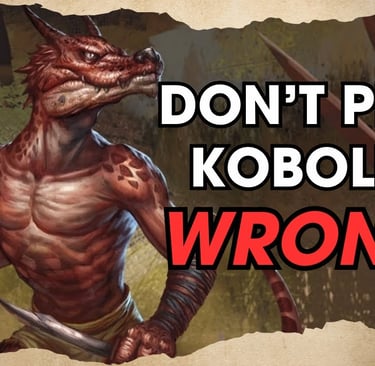Mastering Kobold Combat in D&D 5e
Expert strategies and tactics for playing or mastering kobold encounters in Dungeons & Dragons. This comprehensive guide covers everything from stat block analysis to advanced ambush techniques, environmental traps, and Pack Tactics. Learn how to turn a seemingly weak kobold into a formidable foe in your campaigns. Perfect for Dungeon Masters and players alike!
DUNGEONS AND DRAGONS
5/8/20242 min read


Welcome to our latest guide on playing one of Dungeons & Dragons’ most cunning and crafty creatures: the Kobold. These small, reptilian humanoids might not look like much at first glance, but underestimate them at your peril. In this post, we’ll break down the key strategies for making your kobold encounters challenging and memorable, whether you're a Dungeon Master or a player looking to better understand these pesky opponents.
Understanding the Kobold Stat Block
Kobolds are fragile, with an Armor Class (AC) of 12 and only 5 Hit Points (HP). Their ability scores highlight their physical weaknesses but also their key strength: Dexterity. With a Dexterity score of 15, kobolds have a decent chance to dodge attacks and land their own, especially when using Pack Tactics—a feature that gives them advantage on attack rolls if an ally is within 5 feet of the target. This means kobolds are at their best when fighting in groups, swarming their enemies with coordinated strikes.
Key Strategies for Kobold Combat
Ambush Tactics: Kobolds are natural ambushers. They thrive in environments where they can hide and strike when least expected. Setting up ambushes in narrow corridors or heavily trapped areas can give kobolds the upper hand against even the most seasoned adventurers. Always have kobolds attack in groups to maximize the advantage provided by Pack Tactics.
Hit-and-Run: With their Sling (a ranged weapon with a +4 to hit, dealing 1d4 + 2 damage), kobolds can harass players from a distance and retreat before they can be counterattacked. This tactic is particularly effective in wide open spaces or areas where kobolds can quickly hide after an attack.
Environmental Traps: Kobolds are masters of setting traps to weaken and divide their enemies. Traps like pit falls, snare traps, and tripwires can soften up players before combat begins, or can be used mid-fight to create chaos. For example, a well-placed tripwire might cause a player to fall into a pit, separating them from their party just as the kobolds strike.
Mob Mentality: The key to a successful kobold encounter is focusing on isolated players. Kobolds should aim to overwhelm a single character with multiple attacks, using their daggers (with a +4 to hit and dealing 1d4 + 2 piercing damage) to bring them down quickly before moving on to the next target.
Example Scenario: The Perfect Kobold Ambush
Imagine your players are navigating a narrow, dark tunnel. Kobolds wait in hiding, ready to spring their trap. As the first player steps forward, they trigger a tripwire, causing a rockfall trap to be released from above. The players scramble to react, and in the confusion, kobolds emerge from the shadows, using their Pack Tactics to swarm a single player. Meanwhile, more traps are triggered, causing further chaos and dividing the party. By the time the players regain their footing, they've already suffered significant damage.
Conclusion: Making Kobolds Count
Running kobolds effectively is all about using their numbers, environment, and clever tactics to challenge your players. While they may not be strong individually, a well-coordinated group of kobolds can be a serious threat. By focusing on ambush tactics, hit-and-run strategies, and environmental traps, you can turn even the simplest kobold encounter into a memorable and exciting challenge for your players.
If you found this guide helpful, be sure to check out our other posts on D&D tactics and subscribe to our YouTube channel for more tips and tricks! May your traps be tricky, and your encounters epic!

